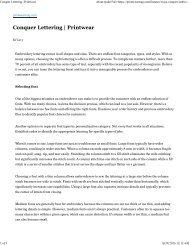Embroidery Basics Articles
You also want an ePaper? Increase the reach of your titles
YUMPU automatically turns print PDFs into web optimized ePapers that Google loves.
10/28/2016 Thick and Thin: So Many Fabrics...So Many ays W <strong>Embroidery</strong> Article<br />
The last category in our diverse order is the caps. Headwear is a dif ferent breed of cat when it comes to digitizing. I’ve devoted<br />
whole articles to this subject, but space does not permit that extensive a review here. Let me just say this, ef ficiency be hanged!<br />
Cap designs perform best when they are digitized from the center out and from the bottom to the top. Why? Though caps are<br />
usually constructed from stable fabrics, most are flimsy and hard to hoop. The most stable part of the cap is near the seam that<br />
secures the crown to the bill, followed by the area of the center seam. W orking up and out from those two stable portions pushes<br />
the fabric the same distance with each pass of the embroidery machine, allowing for better registration in the design.<br />
Other than the digitizing for caps, which is usually something that needs to be done separately , editing a design can usually<br />
provide the changes necessary to move from one fabric type to another . In today’s world of sophisticated digitizing and editing<br />
software, a click of the mouse is all it takes to add underlay when needed.<br />
§<br />
This design, a chef outline, has a center walk underlay , which is suf ficient in making the columns<br />
stand up from the garment in most cases. However , soft knits might need an edge walk to prevent<br />
the stitches from sinking.<br />
Zigzag is the term that seamstresses are familiar with, and is comparable to a light density<br />
column. When this underlay is combined with a center walk or edge walk on satin columns, it<br />
serves the purpose of laying down the “pile” on fabrics such as terrycloth or polar fleece. While the<br />
underlay adds stitches to the design, it saves cleanup time when the embroiderer can eliminate<br />
the use of a topping.<br />
The stitched version, or sewout, of the chef outline.<br />
A filled design generally has underlay stitches that run the opposite direction of the fill patterns.<br />
For most fabrics, this is enough underlay to serve the purposes of tacking the backing to the<br />
garment and making the fill stand up from the garment. This particular design has a satin stitch<br />
that cleans up the edges, as well.<br />
A great way to tame pile that tends to poke its way through fill patterns is to add a secondary<br />
underlay running the opposite direction of the primary underlay . When this is done, both should<br />
run at 45 degree angles to the fill. Since the design has many fill patterns, I chose to digitize a<br />
separate underlay that would encompass the entire design, duplicate that pattern and change the<br />
fill direction of the second to run the opposite direction of the first. In this case, the underlay in the<br />
design is additional, and should take care of any unruly threads that would still try to rear their way<br />
through the both the fill patterns and the columns.<br />
The stitched version of a chef design that combines fill patterns, walk stitches and columns.<br />
§<br />
Hooping<br />
https://www.embroiderydesigns.com/emb_learning/article/559/thickandthinsomanyfabricssomanyways.aspx<br />
Military precision! That’s the term that comes to mind when I think about hooping. Sloppy hooping presents more problems in<br />
2/4




